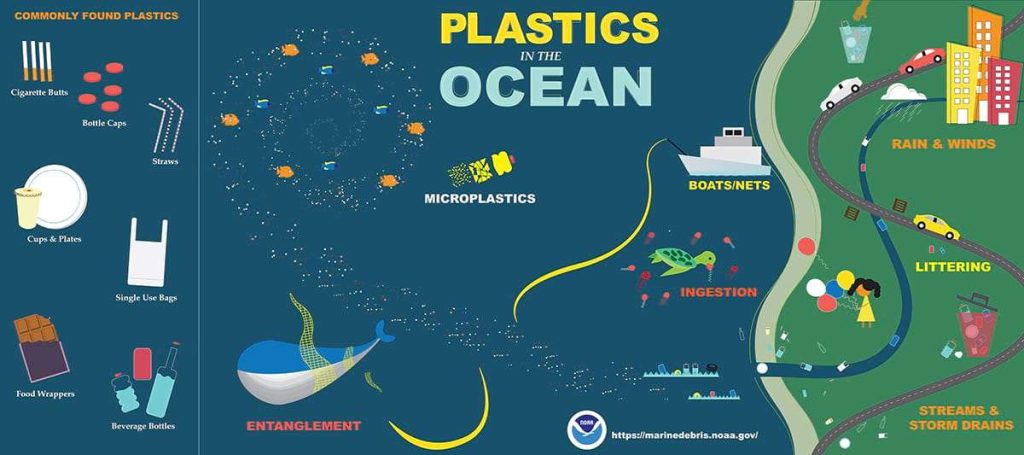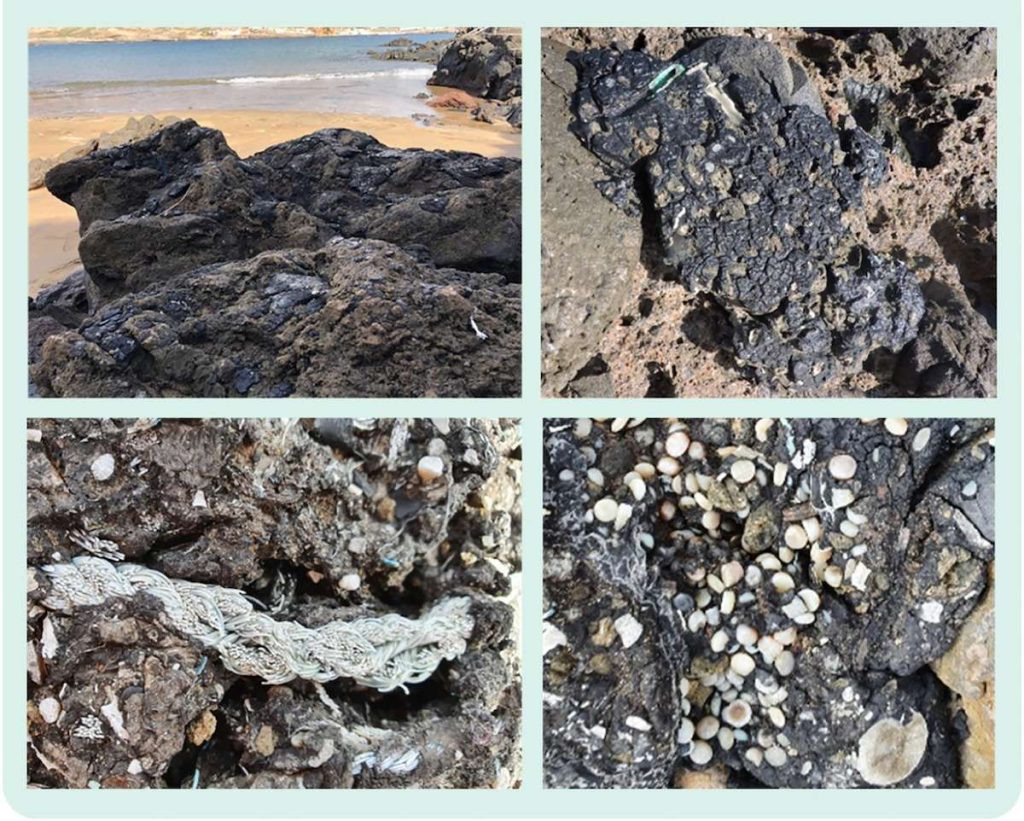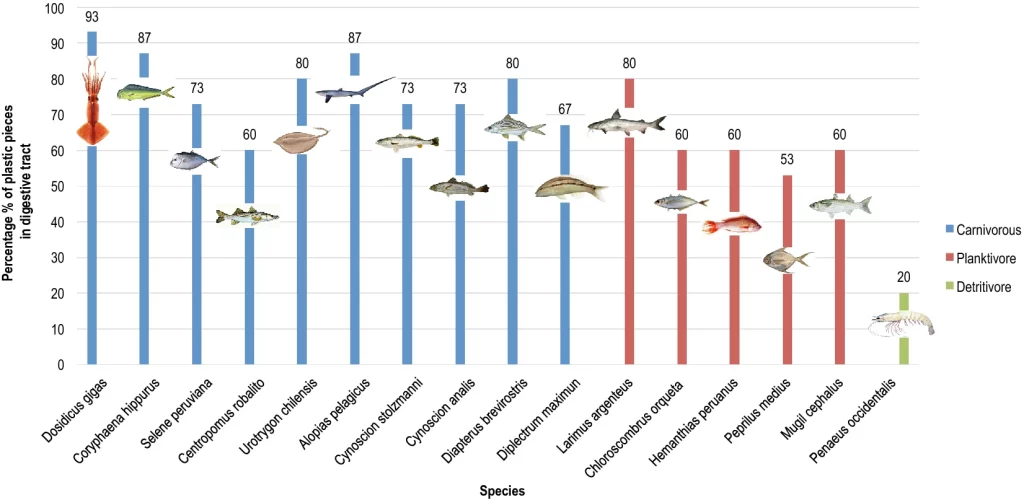Microplastics in the sea have become one of the biggest threats to our planet. Millions of tons of plastic waste continue to make their way to our oceans every year. It takes years for plastic to degrade in the environment. However, when it degrades it breaks down into tiny pieces and remains in the ecosystem indefinitely. Unfortunately, the consequences for the health of our planet and its species are severe.
A large amount of plastic trash in the oceans flows from land via rivers and coastlines. 11 million tons of plastics enter the ocean every year. This is equivalent to one garbage truck dumped into the sea every minute! The volume could nearly triple by 2040 if we carry on the current trajectory.
Source: Explainity
How do We Get Microplastics in the Sea?
Plastics degrade in the following ways:
- Exposure to UV radiation
- Temperature
- Physical abrasion
Plastic degradation in the oceans most often occurs in areas where there are intense waves and currents, causing rapid movement of the debris.
Plastics tend to degrade slowly in water. Larger pieces of plastic, called ‘macroplastics’, break down into microplastics. Microplastics measure less than five millimeters in length.

Reasons for the presence of microplastics in the sea
Plastics are transported to the ocean in several ways:
- Rivers and streams
- Coastlines
- Rain
- Wind
There are three main sources of microplastics in the sea.
Mismanaged waste
Plastics thrown into domestic garbage bins are collected and dumped in landfills. This source of plastic waste is found in countries with poor waste management systems. Wind, for example, can transport lightweight plastics like plastic bags from landfill into waterways that lead to the ocean.
Littering
Plastic can reach the ocean from litter on the streets. The most common discarded plastics include plastic wrappers, single-use plastic cutlery, single-use plastic cups, straws, plastic bottles, cotton buds, and cigarette butts. Rainwater and wind carry them to streams and rivers via drains. This then leads to their accumulation in the ocean. Plastic litter on beaches ends up in the ocean or buried deep in the sand.
Use of cosmetics and personal care products
Personal care, sanitary products and cosmetics that contain microbeads are washed or flushed down the toilets. Microplastics in personal care products accumulate in the sewage system and breakdown into even smaller pieces. Microbeads and these smaller particles, called microfibers, are difficult to filter out. So they stay in the water leaving the sewage plant and finding their way to the waterways and ocean.
Microplastics can also enter the environment in other ways, as shown in the chart below.

Source: OECD Global Plastics Outlook Database
Microplastics in the sea produced from degrading macroplastics were estimated to be around 0.10 Metric tonnes (MT) in 2019.
Worryingly, those microplastics end up in our food chain. People are likely to ingest microplastics when they eat seafood or drink tap water. Plastics contain toxic chemicals and these pose a health risk. Research has found that chemicals in plastics can cause cancer in humans.
A new Plastic discovery in the ocean
Researchers from the Canary Islands in Spain have discovered a new type of plastic contaminant called ‘plastitar‘. It is formed from the residue of oil spills on coasts and coastal rocks. Worse, ‘plastitar’ attracts plastics and other small debris to form a sticky, hardening tarball (Domínguez-Hernández et al., 2022).

More research is required to understand the full effects of plastitar on the marine environment. Nonetheless, this combination of two dangerous marine contaminants – plastic and tar – poses a double threat to marine ecosystems. Both materials can cause injuries, intestinal blockages and death when ingested by marine life (Domínguez-Hernández et al., 2022).
Tellingly, the discovery of plastitar shows how this problem could continue to evolve and even worsen. Elements can interact with each other and create new problems that we have not anticipated.
How do Microplastics in the Sea Impact Marine Life?
Microplastics exist in various marine organisms, including coral, plankton, fish, seabirds and marine mammals. The most visible effect of microplastics is the increase in the mortality rate. Sea creatures eat microplastics, often confusing it for sources of food or prey.
The ingestion of microplastics causes the blockage of digestive tracts, reduction in the urge to eat, and alteration of feeding behaviour, all of which reduce the growth and reproductive output of marine life.
Research on Microplastics in marine species
There is ongoing research on microplastic contamination and consumption. A study on microplastic pollution across the Tropical Eastern Pacific and Galápagos shows the prevalence of microplastic contamination and consumption by marine organisms. The study analyses the digestive tracts of 240 marine organisms of 16 different species. These include fish, squid, shrimp, cephalopod molluscs and crustaceans. The size of microplastics observed in all water samples and marine organisms was mostly between 150 to 500 µm.

source: https://www.nature.com/articles/s41598-021-85939-3/figures/3
Microplastics were found in 166 out of 240 cases from the 16 different species observed. 77% of carnivorous species had microplastic pieces in their digestive tract. This was closely followed by planktivorous (63%) and detritivores (20%). Meanwhile, 93% of the Dosidicus gigas (giant squid) had microplastics in their digestive tract.
Comparatively, planktivorous species tended to have a lower risk of plastic ingestion to the carnivorous species.
Can Microplastics be removed from the ocean?
Researchers, scientists, and entrepreneurs are finding novel ways to address microplastics in the ocean environment. Some innovative techniques include:
The Ocean Cleanup
Founded in 2013, ‘The Ocean Cleanup‘ is a non-profit organization that has created high-tech floating systems. It has designed interceptors to capture garbage, including microplastics and larger debris, in rivers and oceans. The interceptors are located in several parts of the world, including an area near to the ‘great pacific garbage patch‘. This patch has the largest accumulation of ocean plastic in the world.
Robot Fish
Researchers at Sichuan University have developed a tiny automotive ‘robotic fish’ that can swim around and latch onto plastic in the ocean. The robot fish has a laser system in its tail, allowing it to move at a speed of 30mm per second. Moreover, this self-propelled bot is stretchy and flexible, and can carry five kilograms of weight. That allows it to absorb floating bits of plastic nearby with the aid of strong chemical and electrostatic bonds.
The Hoola One
‘Hoola One’ is a Canadian invention that aims to remove microplastics embedded in beach sand with a buoyancy technique. This hoover-like contraption vacuums the sand, collecting microplastics and other debris into a container full of water. The water tank separates floating microplastics and returns the clean sand to the beach. Hoola One can clean three gallons of sand a minute and gobble up to 48 kilograms of microplastics in just a few hours!
The Seabin Project
A clean-up effort called the ‘Seabin Project’ began on a small scale in Australia. The project distributes plastic-catching garbage bins to harbors, marinas and ports. These bins move with the tides, filtering seawater and capturing any floating waste nearby. Over 800 Seabins are located currently in more than 50 countries. Each one can capture 1.4 tonnes of waste a year.
Nano-coating for plastic
A team of Swedish and Lebanese researchers are developing a nano-coating for plastic. The nano-coating is made out of chemicals that react to sunlight. The reaction weakens the plastic, causing it to crack and break apart. This coating can reduce the volume of microplastic particles by 65% after just a few weeks of light exposure. Researches believe microplastics can even be totally eradicated if there is enough sunlight exposure.
Magnetic carbon nano-tubes
Researchers in Australia discovered a technique that uses spring-shaped ‘carbon nanotubes’ to catalyse the breakdown of microplastic particles. A persulfate salt (oxidant) activates sulfate and hydroxyl radicals to attack the microplastic. This causes it to break down, generating water and carbon dioxide. The carbon nanotube helps to filter microplastics in sewage treatment plants before the water is released into the ocean (Su, Y. et al., 2020).
Are microplastic removal methods effective?
Although there are many innovative ways to remove microplastics from oceans, none have been proven 100% effective. Also, the number of microplastics buried deep in the seafloor is unknown, which makes it difficult to estimate how much is there. Further research is required to understand the repercussions of using such methods to decontaminate the sea.
In addition, it is crucial to consider the following when embarking on a large scale removal of microplastics from the ocean:
- The effectiveness of alternative methods;
- the cost of large-scale removal of microplastics from ocean waters and;
- the effects of removal methods, including their potential to harm microorganisms in marine environments (Tekman, M. B. 2022).
Other Pathways
Importantly, countries must strengthen national policies and collaborate with stakeholders to reduce the leakage of microplastics. Microplastic pollution must be reduced with innovative policy, strong institutions, effective systems, and the right incentives in place.
Policies
Cities must prioritize better waste management policies and directly address plastics disposal. Examples of these policies include restrictions on the production and sale of single-use plastics, and micro-beads in cosmetics. They also include improved waste management practices and taxes on plastics, including plastic packaging.
Market incentives encourage consumers to be more environmentally conscious. For example, the deposit-refund system for PET (plastic) bottles encourages recycling. However, this method alone might not encourage consumers to use fewer plastics. So, understanding the impact of incentives is important.
Also, policy frameworks must focus on how microplastics are caused by wear and tear on certain products. This is an important area of commercial policy that has largely been ignored to date.
Industry Support
A far simpler approach to preventing plastics from entering the environment is to reduce plastic production. Industries must play a crucial role in this regard. We can reduce the dependence on plastic by altering manufacturing processes. Reducing the overall volume of plastic material is aided by using recycled materials or designing degradable/recyclable products. Manufacturers may also consider sustainable packaging.
Plastic waste from industry can be collected and recycled into a variety of products. For example, construction materials, bags, books, and even materials for the building of roads.
Knowledge and awareness
Governments, non-profit organizations, academia and relevant stakeholders must intensify efforts to educate the public. Large scale campaigns on the effects of microplastics on the environment and public health are necessary. Community engagement activities and strategies will also play a vital role in reinforcing environmental awareness.
Recent wins to reduce microplastic pollution in the Seas
Nations and industry are increasingly showing interest in addressing plastic pollution. There is a list of countries already adopting regulations at the national level. Also, a number have signed international resolutions pledging to end plastic pollution.
Legislation adopted by countries to regulate plastics
As of 2018, several countries have adopted some form of legislation to regulate plastics:
- 127 out of 192 countries have adopted legislation to regulate plastic bags.
- Eight out of 192 countries worldwide have established bans on micro-beads.
- 27 countries have enacted legislation banning specific plastic products, materials, and production levels.
- 27 countries have imposed taxes on the manufacture and production of plastic bags.
- 30 countries charge consumers fees for plastic bags at a national level.
- 43 countries have factored in extended producer responsibility for plastic bags within their legislation.
- 63 countries have mandates for extended producer responsibility for single-use plastics, including deposit refunds, product take-back, and recycling targets.
Not many countries have specific laws that place controls on plastic manufacturers, adopt recycling targets, or impose higher costs to reduce the purchase of plastic products. Monitoring the implementation and impact of these regulations is crucial to further encourage policies that reduce plastic pollution and protect marine life.
Platforms established to resolve microplastic pollution in the oceans
There are global platforms that assist governments, non-profit organizations, civil society groups, industries and other stakeholders to address plastic pollution. These networks lead the way in finding ways to minimize plastic production and address its usage.
Some of these networks include:
- Global Commitment
- Clean Seas platform
- UN Resolution adopted by the United Nations Environmental Assembly
is there a way out for microplastics in the Sea?
By now, it is evident that there is no single solution to completely remove microplastics from the ocean. More funding and research is necessary to address the gaps in our knowledge on the impact of microplastics.
The control and management of microplastics is likely to require greater strategic prioritization by stakeholders and a careful consideration of the impacts.
If countries continue to adopt specific legislation regulating plastics, they will be more likely to meet their international obligations under the Sustainable Development Goal (SDG) 14. SDG seeks to ensure the conservation and sustainable use of oceans.
To find out more about Sustainable Development Goals and the measures being taken to address climate change and ecological damage, join THRIVE.
Make sure to sign up for Thrive Newsletters and check out the latest news from our blog, podcasts and webinar events and stay up to date on sustainability-related matters.
References:
- Domínguez-Hernández, C. et al. (2022) ‘Plastitar: A new threat for coastal environments’, Science of The Total Environment, 839(May), p. 156261. doi: 10.1016/j.scitotenv.2022.156261.
- Tekman, M. B. (2022) ‘Impacts of Plastic Pollution in the Oceans on Marine Species, Biodiversity and Ecosystems Summary of a Study for Wwf by Summary of a Study for Wwf by Wwf International 2022 3 Summary’. doi: 10.5281/zenodo.5898684.
- Su, Y. et al. (2020) ‘Removal of microplastics from aqueous solutions by magnetic carbon nanotubes’, (August). doi: 10.1016/j.cej.2020.126804.
- Omoyajowo, K. et al. (2022) Public Awareness, Knowledge, Attitude and Perception on Microplastics Pollution Around Lagos Lagoon. Ecological Safety and Balanced Use of Resources, (2(24), 35–46. https://doi.org/10.31471/2415-3184-2021-2(24)-35-46























